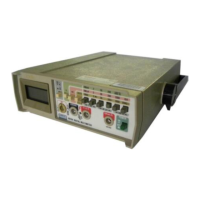Section
3
Theory
Of
Operation
3-1.
INTRODUCTION
3-2.
The theory of operation of your
Multimeter
is
discussed on two
levels.
First,
the
Functional Description
describes
the operation of
your
instrument
in terms of the
functional relationships of the major circuits.
Second,
the
Circuit Description presents a more detailed
discussion of
the major circuits. Both levels are illustrated
by block
diagrams and simplified schematics in this section
and the
schematic diagrams in Section
7.
Section
6 contains the
theory of
operation
of
the Rechargeable
Battery Option.
3-3.
FUNCTIONAL
DESCRIPTION
3-4.
The major
circuits
of your Multimeter are
illustrated in the functional block diagram in Figure
3-1.
The
functional block diagram
shows
that
the
multimeter
can
be
divided into two general circuits, the
Input
Signal
Conditioners and the Digital
Voltmeter.
The
Signal
Conditioners are responsible for converting
current,
.
resistance,
conductance,
and
ac
or
dc
voltage to
an
analogue dc voltage (proportional to the input)
from
-200
mV
to 200
mV or
-2V to 2V for the digital
voltmeter.
The
signal conditioner circuits also provide protection
from
transients and
overrange
conditions. The Digital
Voltmeter
is
composed of a custom IC
(U3)
and the
LCD
Display. The
custom
IC
contains an
analog
to digital
converter (a/d), a
controller,
and the LCD
drivers.
3-5.
These two circuit groups work together as follows:
An input
signal
(of
unknown value)
is applied
to its
respective signal conditioning block by the selection
of
the
mA,
V,
or kfl (S=l
/
fi.)
front panel function
switches.
(For this
discussion,
the lOA function switch
for the
8010A
and the
LO
RANGE H function switch
for the
8012A will be presented as extensions of the current
and
resistance signal conditioners.) The
output
voltage of the
signal conditioners is a proportional analogue
of the
input signal. This output voltage will be from
-200
mV to
200
mV
or
-2V to 2V, depending on the selected
range.
The dc output of
the conditioners
is
sent
directly to the
'
A/D Converter. The ac output of the
conditioners
is
converted
to dc by a true-rms converter
before
reaching
the A/D Converter. Once the analog
voltages
have been
conditioned,
the
A/D Converter
converts the
unknown
voltage (which represents the signal
measured
with
the
Multimeter) into representative,
digital
information.
This
digital information is then used by the
LCD drivers
to
present the reading on the LCD.
The position
of the
decimal point is determined by the
Range Switch
settings.
3-6.
CIRCUIT DESCRIPTIONS
3-7.
The following paragraphs
describe
each of the
major
circuits
in detail.
3-8.
Digital Voltmeter
3-9
. The Digital Voltmeter of
your
Multimeter
consists
of
the
custom
IC (U3) and the 3-1/2
digit
LCD. The
custom IC
contains
an a/ d converter,
a digital
controller,
and the display logic and drivers for the
LCD. The
proper
function of U3 depends on external
components
to
establish the basic timing and analog levels.
Basic timing
is provided by a
quartz crystal
(Yl).
Resistors,
capacitors,
and an
external
voltage reference
provide the analog
levels for the A/D Converter.
3-10.
The Digital Voltmeter
has two
ranges
of
measurement.
If you select either the
200 mV or 20V
ranges (or their equivalent ranges
in other functions)
the
Digital
Voltmeter
can read voltages
from
-200
mV
to 200
mV.
Selection of
any other range will
enable
the
Digital
Voltmeter
to read -2V to 2V.
3-11.
A/D CONVERTER
3-12.
The A/D
Converter
uses the
dual slope
integration method. Dual
slope
integration
takes
advantage of the natural laws
governing
the
charge
and
discharge
of
capacitors.
In dual slope
integration,
the
unknown voltage is used
to
charge a
capacitor
for a
specific
length of time.
Then a
known
voltage of
the
3-1

